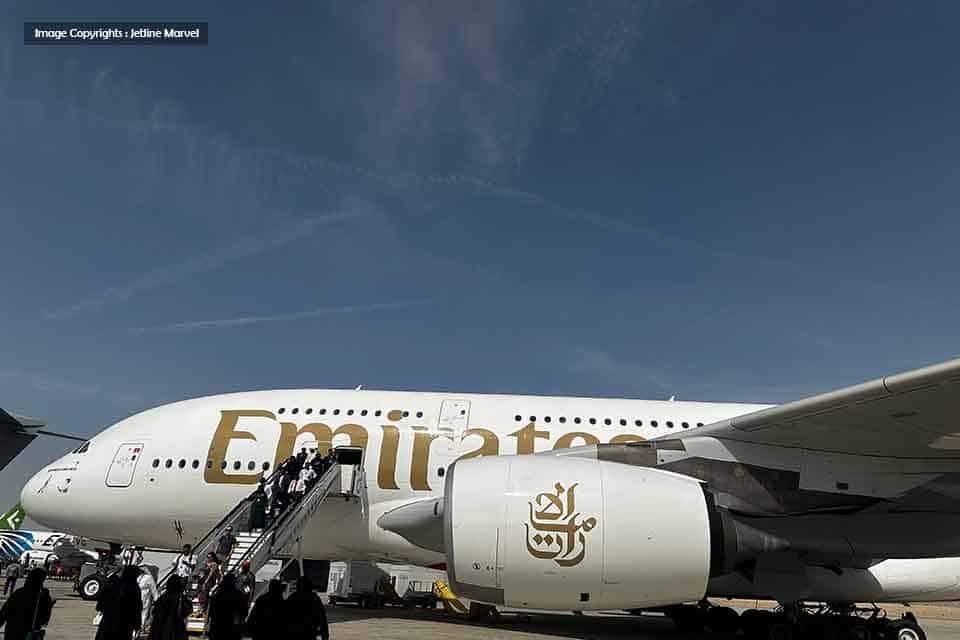Airlines
Emirates’ flagship A380 to return to Perth’s skies from 1 December
Emirates will reintroduce its flagship A380 to Perth as part of the airline’s ramp-up of services to Australia. The up gauge will increase Emirates’ seating capacity between its hub Dubai and Perth, with close to 500 seats available on each flight.

From 1 December, Emirates will reintroduce its flagship A380 to Perth as part of the airline’s ramp up of services to Australia. The up gauge will increase Emirates’ seating capacity between its hub Dubai and Perth, with close to 500 seats available on each flight.
EK420 from Dubai will depart at 02:45, arriving in Perth at 17:20 the same day while EK421 flight will depart from Perth at 22:20, arriving in Dubai at 05:25 the following day. The daily A380 service will replace the existing daily Boeing 777- 300ER operation between Dubai and Perth.
The up gauge comes as Emirates proudly celebrates 20 years of serving the skies and communities of Perth, offering unparalleled connectivity to Dubai and across its global network.
20 Years of Flying to Perth
Since its inaugural flight to Perth back in August 2002, Emirates has flown close to 6 million passengers between Perth and its Dubai hub, travelling more than 220 million kilometers on over 24,000 flights.
Initially starting as a four times weekly service, the airline expanded its Perth operations due to strong demand for travel, the seamless connectivity provided by the airline, coupled with its award winning product and hospitality. This grew to a daily operation in May 2003 and was followed by the opening of Emirates’ first Perth lounge in February 2006.
Emirates has also been a longstanding supporter of arts, cultural and sporting institutions during this period in Western Australia, with investments across a number of initiatives.
The airline’s cargo arm, Emirates Sky Cargo, has also been an important contributor to the local economy, exporting meat, fruit and vegetables and mining equipment across the airline’s global route network including the Middle East, Europe and beyond.
The Demand for Travel
Emirates has seen a strong increase in passenger bookings to and from Australia with significant demand across all its cabins, particularly following the launch of its Premium Economy which was first introduced on one of its daily Sydney services on 1 August.
The European summer has been the biggest driver of demand for Emirates, with European cities making up 8 of its top ten destinations Australians are currently flying to. Topping the list is the UK followed by Italy, France, Greece and Ireland making up the top five. Spain, Lebanon, Germany, The Netherlands and Turkey round out the top 10 destinations.
Many Emirates passengers are taking advantage of stopover travel, with the airline seeing a strong increase in the number of passengers who have enjoyed a brief stop in Dubai. Dubai Experience, which launched in April across 20 markets including Australia, helps passengers explore everything about Dubai and the UAE.
Flying with Emirates
Customers of Emirates and Qantas have access to an expansive network of destinations thanks to the codeshare partnership between the two airlines. Together, Emirates and Qantas provide customers access to more than 100 codeshare destinations, including 55 points across Australia and New Zealand. Qantas customers can fly with Emirates to Dubai and access over 50 cities in Europe, the Middle East and Africa.
Emirates remains focused on taking the stress out of travel and has led the industry in protecting the health of its customers. Emirates’ customers travel with the assurance that the latest health and safety measures are in place at every step of the journey.

Airlines
Air India’s last VVIP Boeing 747 now found a new home in USA

In a symbolic transition marking the end of a storied chapter in aviation history, Air India bid farewell to its last remaining Boeing 747-400 jumbo jetliners, once revered for ferrying dignitaries including prime ministers, presidents, and vice presidents.
The sale of these iconic aircraft to AerSale, a company based in the United States, signals the closure of a remarkable era for the airline.
The decision to part ways with the Boeing 747s was driven by practical considerations. Tata Group, the new custodian of airindia flights, deemed these majestic planes uneconomical to operate in today’s aviation landscape. As such, out of the four sold, two will be repurposed into freighters, while the remaining pair will be meticulously disassembled to harness their valuable parts.
The transaction, orchestrated by Mumbai-based Vman Aviation Services, underscores the strategic shift in Air India’s fleet management strategy under its new ownership. Tata Group’s decision to divest from the 747s reflects a commitment to optimizing operational efficiency and aligning with contemporary industry standards.
Skytech-AIC, a UK-based remarketing firm engaged by Tata Group, facilitated the sale of these iconic aircraft, marking the conclusion of their illustrious service with Air India. The airline’s last flight featuring the Boeing 747 took to the skies between Delhi and Mumbai in March 2021, encapsulating decades of distinguished service and indelible memories.
The allure of used aircraft parts continues to resonate across the aviation sector, offering operators a cost-effective alternative without compromising on quality or performance. The transfer of these aircraft to AerSale not only ensures their continued utility but also underscores the enduring legacy of Air India’s fleet.
Airlines
A software error caused grounding the entire airline fleet

On Wednesday, the U.S. Federal Aviation Administration (FAA) issued a ground stop advisory for all Alaska Airlines and subcarrier flights due to a software issue, disrupting travel plans for passengers.
The FAA directive, which prohibited the departure of Alaska Airlines mainline and subcarrier flights, was implemented as a precautionary measure following the detection of the software problem. The ground stop was initiated after Alaska Airlines encountered difficulties during a system upgrade related to the calculation of weight and balance for their flights.
As a result, the airline opted for a temporary suspension of all its operations to address the issue and ensure passenger safety. Alaska Airlines promptly issued a statement acknowledging the incident and expressing their commitment to resolving the matter swiftly. “This morning we experienced an issue while performing an upgrade to the system that calculates our weight and balance.
Out of an abundance of caution, we requested a ground stop for all Alaska and Horizon flights, which was instituted at approximately 7:30 a.m. PT,” the statement read. Passengers affected by the disruption voiced their concerns on social media platforms, prompting Alaska Airlines to reassure them of their efforts to minimize the inconvenience and expedite the resumption of flights.
Following approximately an hour-long interruption, the FAA lifted the ground stop order, allowing Alaska Airlines and its subcarriers to resume normal operations. However, it was clarified that SkyWest, which provides regional service for Alaska Airlines and other carriers, was exempt from the ground stop and continued its flights unaffected.
Aerospace
Which is bigger 777x or 787 aircraft ?

The 777X is a new series of the Boeing 777 family and is designed to be larger and more efficient than its predecessor. It features two variants: the 777-8 and the 777-9, being the larger of the two.
The Boeing 777X emerges as the larger sibling within the Boeing family, representing a significant leap forward in both size and efficiency. Comprising two variants, the 777-8 and the 777-9, the latter takes the crown as the larger of the two. With its expansive fuselage and impressive wingspan, the 777X is tailored for long-range journeys and boasts a substantial passenger capacity.
On the other hand, the Boeing 787, affectionately known as the Dreamliner, occupies a niche in the market as a smaller yet formidable aircraft designed for medium to long-range flights. Its distinguishing feature lies in its composite fuselage, a technological marvel that renders it lighter and more fuel-efficient compared to conventional aluminum counterparts. The Boeing 777X is larger than the Boeing 787 aircraft.
When it comes to passenger capacity, the 777-9 reigns supreme, typically accommodating a sizeable contingent of 400-425 passengers in its standard configuration. In contrast, the 787, with its more modest dimensions, typically carries between 240-290 passengers, depending on the variant and layout.
One of the remarkable innovations introduced with the 777X is its folding wingtips, a feature designed to address the logistical challenges of accommodating such a large aircraft in conventional airport gates. These folding wingtips enable the 777X to retract its wings, allowing it to fit into gates designed for smaller aircraft while still reaping the benefits of an extended wingspan during flight, thereby enhancing fuel efficiency and operational flexibility



























